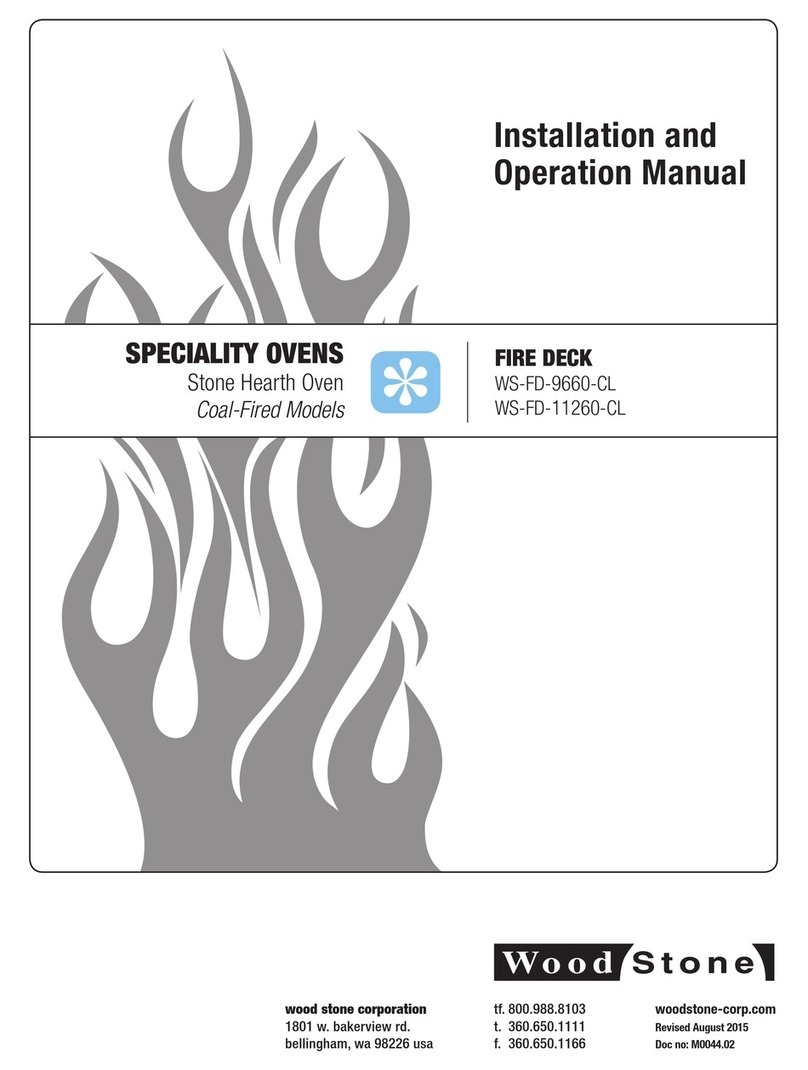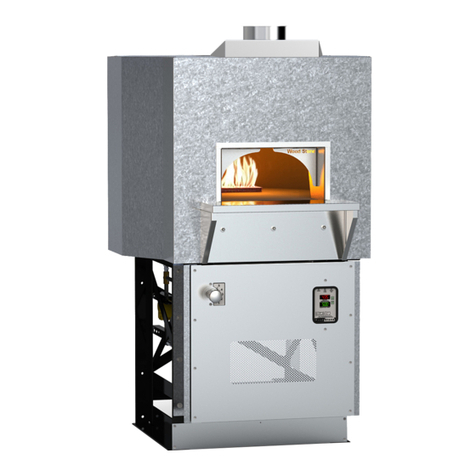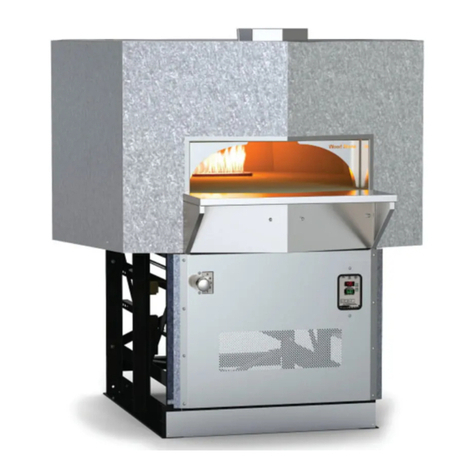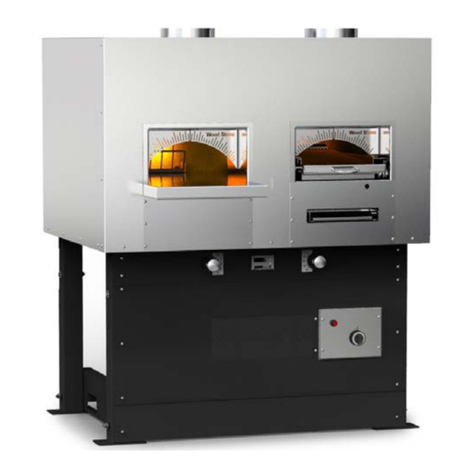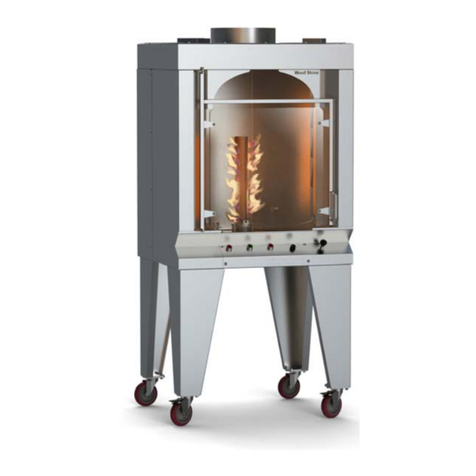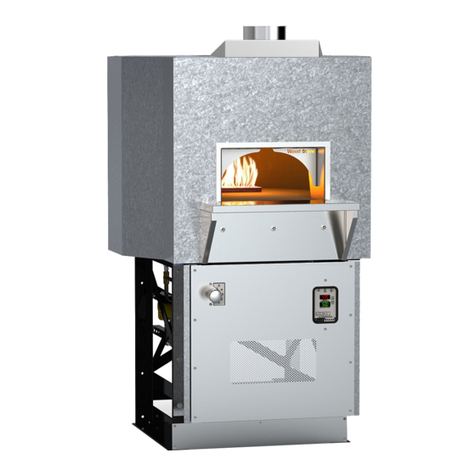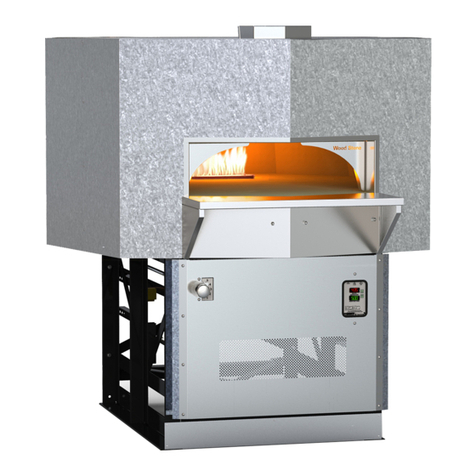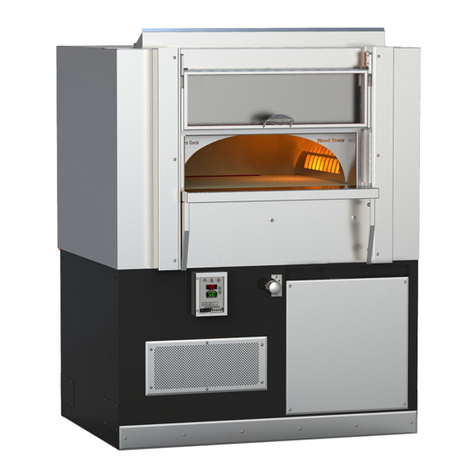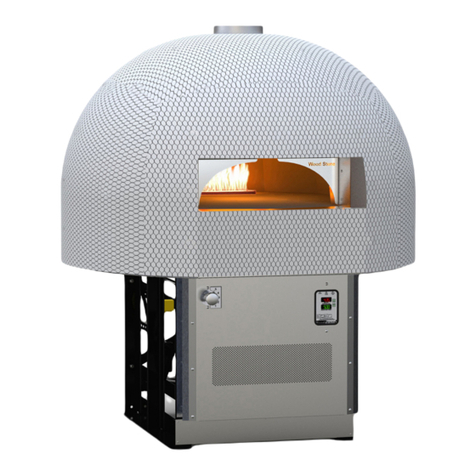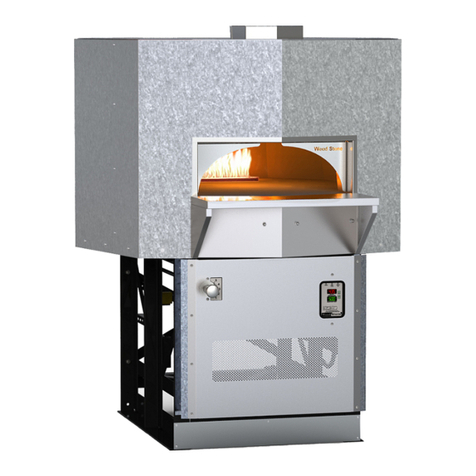
FD-9660 and FD-11260 Fire Deck Oven
Installation and Operation Manual
An ongoing program of product improvement may require us to change
specifications without notice. FD-9660, FD-11260,
Revised September 2014. Doc no: M0040.01
wood stone corporation
1801 w. bakerview rd.
bellingham, wa 98226 usa
tf. 800.988.8103
t. 360.650.1111
f. 360.650.1166
5
UTILITIES SPECIFICATIONS
Gas: 1 inch FNPT gas inlet
350,000 BTU/hr Natural Gas (NG)
OR
369,000 BTU/hr Propane (LP)
Optional Decorative Flame
Adds 15,000 BTU/hr
Maximum gas inlet pressure:
1/2 psi (14 inches W�C�)
Electrical
120 VAC, 2 A, 50/60 Hz
Utility connections made underneath
the oven�
Refer to data plate when installing�
Venting information
The Fire Deck 9660 can be direct connected to a power-ventilated,
grease-rated chimney or can be vented with a Listed Type 1 exhaust
hood, or one constructed in accordance with NFPA 96 and all relevant
local and national codes�The oven must be vented in accordance with
all relevant local and national codes, and in a manner acceptable to
the authority having jurisdiction�
IMPORTANT: Ovens with model numbers containing a -W must be vented
as a solid fuel appliance�
Side view
FD-9660 SPECIFICATIONS
Shipping weight: 6,000 lbs.
Air intake: Do not
facade or cover over
Must be left
removable for service
NOTE: Using the temporary optional casters
will add 3" to the total height of the oven,
for a total of 82-1/2"�
REV:
LEGEND:
PART #:
001-509660
9660 Fire Deck Oven
General Arrangement
3/14/2014 bena
4
DWN BY:
SHEET:
Bellingham, WA 360/650-1111 www.woodstone-corp.com
DIMENSIONS ARE IN INCHES
TOLERANCES: LINEAR ±1/2 [±10mm], ANGULAR ±2°
UNLESS NOTED OTHERWISE
\\woodstone.net\dfs\CAD\0 Pn\WS Top Level\FD-Fire_Deck\FD-9660_General_Arrangement-4.dft
THE INFORMATION CONTAINED IN THIS DRAWING IS THE
SOLE PROPERTY OF WOOD STONE CORPORATION
ANY REPRODUCTION OR USE IN PART OR AS A WHOLE
WITHOUT THE WRITTEN PERMISSION OF WOOD STONE IS
PROHIBITED
AN ONGOING PROGRAM OF PRODUCT IMPROVEMENT
MAY REQUIRE US TO CHANGE SPECIFICATIONS
WITHOUT NOTICE.
DATE:
G
120VAC, 4A
GAS INLET: 1" NPT
225,000 BTU, NG
200,000 BTU, LP
1 of 1
AIR INTAKE
53 3/4"
1370mm
9 3/4"
250mm
95 3/4"
2440mm
57 3/4"
1470mm
9 3/4"
250mm
24 3/4"
630mm
14"
360mm
30"
760mm
4"
100mm
G
2"
50mm
9 3/4"
250mm
2 3/4"
70mm
18"
460mm
13 1/2"
340mm
29 3/4"
760mm
48 1/4"
1230mm
7"
180mm
8"
200mm
25 1/2"
650mm
95 3/4"
2440mm
67"
1700mm
7 1/2"
190mm
77 1/2"
1970mm
37 1/2"
950mm 57 1/2"
1460mm
2 3/4"
70mm
2"
50mm
33 3/4"
850mm
95 1/2"
2430mm
79 1/2"
2020mm
Plan view
Front view
REV:
LEGEND:
PART #:
001-509660
9660 Fire Deck Oven
General Arrangement
3/14/2014 bena
4
DWN BY:
SHEET:
Bellingham, WA 360/650-1111 www.woodstone-corp.com
DIMENSIONS ARE IN INCHES
TOLERANCES: LINEAR ±1/2 [±10mm], ANGULAR ±2°
UNLESS NOTED OTHERWISE
\\woodstone.net\dfs\CAD\0 Pn\WS Top Level\FD-Fire_Deck\FD-9660_General_Arrangement-4.dft
THE INFORMATION CONTAINED IN THIS DRAWING IS THE
SOLE PROPERTY OF WOOD STONE CORPORATION
ANY REPRODUCTION OR USE IN PART OR AS A WHOLE
WITHOUT THE WRITTEN PERMISSION OF WOOD STONE IS
PROHIBITED
AN ONGOING PROGRAM OF PRODUCT IMPROVEMENT
MAY REQUIRE US TO CHANGE SPECIFICATIONS
WITHOUT NOTICE.
DATE:
G
120VAC, 4A
GAS INLET: 1" NPT
225,000 BTU, NG
200,000 BTU, LP
1 of 1
AIR INTAKE
G
12"
310mm OD
95 3/4"
2440mm
57 3/4"
1470mm
9 3/4"
250mm
24 3/4"
630mm
14"
360mm
30"
760mm
4"
100mm
G
2"
50mm
9 3/4"
250mm
2 3/4"
70mm
18"
460mm
13 1/2"
340mm
29 3/4"
760mm
48 1/4"
1230mm
7"
180mm
8"
200mm
25 1/2"
650mm
95 3/4"
2440mm
67"
1700mm
7 1/2"
190mm
77 1/2"
1970mm
37 1/2"
950mm 57 1/2"
1460mm
2 3/4"
70mm
2"
50mm
33 3/4"
850mm
95 1/2"
2430mm
79 1/2"
2020mm
REV:
LEGEND:
PART #:
001-509660
9660 Fire Deck Oven
General Arrangement
3/14/2014 bena
4
DWN BY:
SHEET:
Bellingham, WA 360/650-1111 www.woodstone-corp.com
DIMENSIONS ARE IN INCHES
TOLERANCES: LINEAR ±1/2 [±10mm], ANGULAR ±2°
UNLESS NOTED OTHERWISE
\\woodstone.net\dfs\CAD\0 Pn\WS Top Level\FD-Fire_Deck\FD-9660_General_Arrangement-4.dft
THE INFORMATION CONTAINED IN THIS DRAWING IS THE
SOLE PROPERTY OF WOOD STONE CORPORATION
ANY REPRODUCTION OR USE IN PART OR AS A WHOLE
WITHOUT THE WRITTEN PERMISSION OF WOOD STONE IS
PROHIBITED
AN ONGOING PROGRAM OF PRODUCT IMPROVEMENT
MAY REQUIRE US TO CHANGE SPECIFICATIONS
WITHOUT NOTICE.
DATE:
G
120VAC, 4A
GAS INLET: 1" NPT
225,000 BTU, NG
200,000 BTU, LP
1 of 1
AIR INTAKE
G
12"
310mm OD
53 3/4"
1370mm
9 3/4"
250mm
95 3/4"
2440mm
57 3/4"
1470mm
9 3/4"
250mm
24 3/4"
630mm
14"
360mm
30"
760mm
4"
100mm
G
2"
50mm
9 3/4"
250mm
2 3/4"
70mm
18"
460mm
13 1/2"
340mm
29 3/4"
760mm
48 1/4"
1230mm
7"
180mm
8"
200mm
25 1/2"
650mm
95 3/4"
2440mm
67"
1700mm
7 1/2"
190mm
77 1/2"
1970mm
37 1/2"
950mm 57 1/2"
1460mm
33 3/4"
850mm
95 1/2"
2430mm
79 1/2"
2020mm
